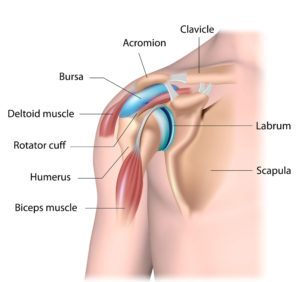An Overview on Shoulder Anatomy
The shoulder is classified as the most flexible joint in the body and is formed where the humerus (upper arm bone) fits into the scapula (shoulder blade). The connection of the humerus and scapula form a ball and socket joint, responsible for a wide range of motion. Other important structures involved in shoulder anatomy include joints within the shoulder, cartilage, ligaments, tendons and muscles. Working in unison, all of these structures provide mobility and allow individuals to live actively. When there is damage from overuse, an injury or degeneration from the natural aging process, patients in the Santa Barbara, Goleta, Santa Maria and Ventura, California area can experience shoulder pain and other troublesome symptoms. Dr. Jervis Yau, orthopedic shoulder specialist, is highly experienced at diagnosing and treating shoulder injuries in order to restore function and decrease pain.
Anatomy of the Shoulder
The shoulder is one of the largest and most complex joints in the body composed of several bones, including:
- Humerus (upper arm bone)
- Scapula (shoulder blade)
- Clavicle (collarbone)
- Acromion (bony projection of the scapula)
- Coracoid process (hook-like bony projection from the shoulder blade)
The scapula extends up and around the rear of the shoulder joint to form the roof, commonly known as the acromion. At the front of the shoulder joint the scapular protrusion forms the coracoid process. The end of the scapula is known as the glenoid, which along with the humeral head forms the glenohumeral joint.
The humerus, scapula and clavicle form three separate joints within the shoulder, including:
- Acromioclavicular (AC) joint: Provides stability and is located at the top of the shoulder.
- Sternoclavicular (SC) joint: Allows clavicular motion and is located at the center of the chest.
- Glenohumeral joint: Formed by the humeral head and glenoid which allow for flexion, extension, abduction, adduction and rotation.
Other important shoulder structures:
- Articular cartilage: The smooth, white substance covers the ends of each bone and provides a fluid, pain-free gliding surface for the bones.
- Labrum: A ring of fibrous cartilage surrounding the glenoid that is responsible for stabilizing the shoulder joint.
- Rotator cuff: A collection of muscle-tendon units responsible for providing support, strength and motion of the shoulder.
A sophisticated system of ligaments connects the bones of the shoulder, while numerous tendons attach the muscles to bone. All of these structures work together to allow for fluid shoulder movement and stability.
Injuries to any of these structures can lead to joint pain, loss of motion and other troublesome symptoms.
Common injuries to the shoulder include:
- Rotator cuff injuries
- Shoulder impingement
- Frozen shoulder
- Shoulder instability
- AC joint injury
- SC joint injury
- Shoulder fractures
To learn more about shoulder anatomy, or to determine the cause of your joint pain, please contact the Santa Barbara, Goleta, Santa Maria and Ventura, California orthopedic office of shoulder specialist Dr. Jervis Yau.
